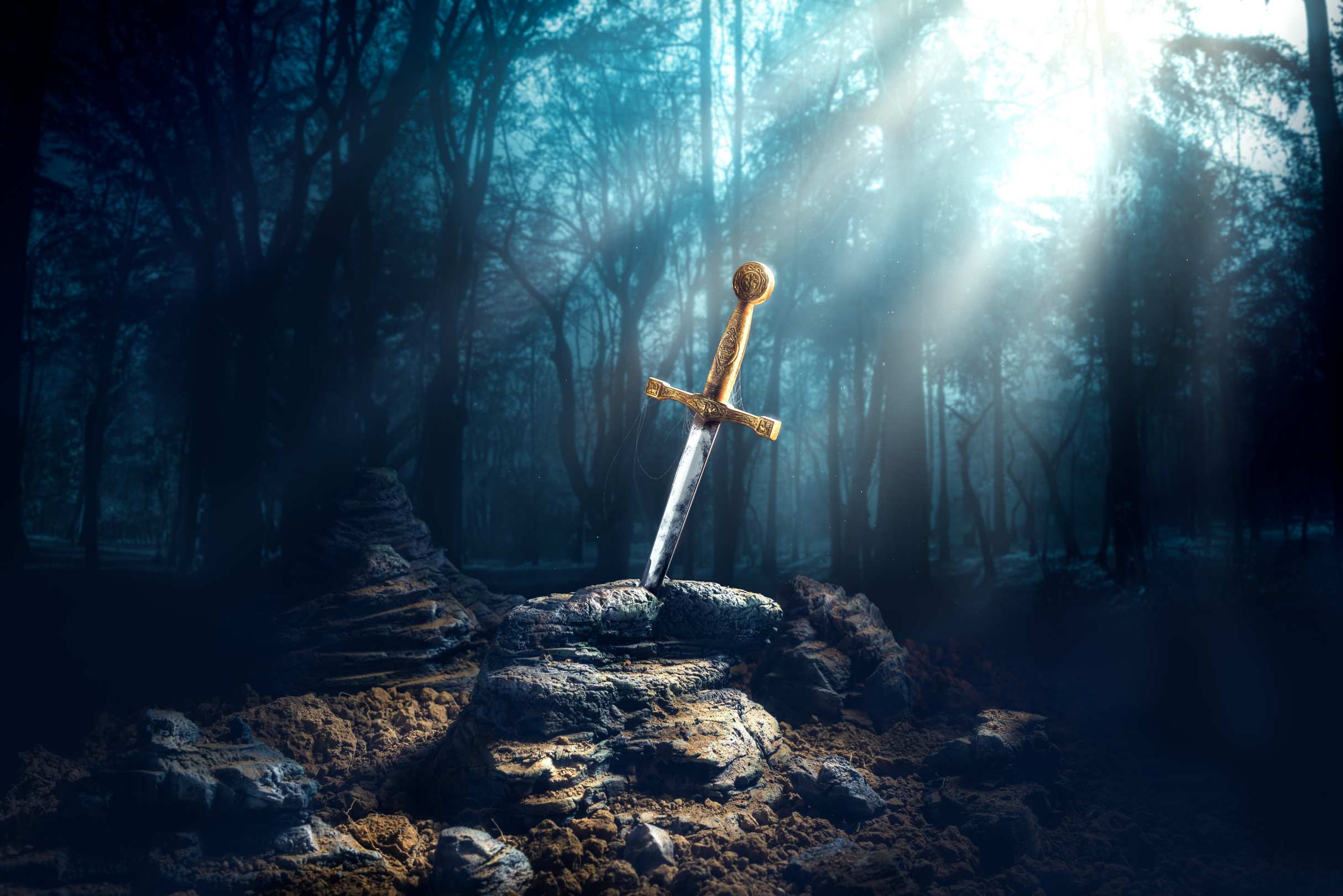As a lover of history and mythology, one of the most fascinating tales that has always captured my imagination is the legend of King Arthur and his sword Excalibur. The stories of Arthur and his knights of the Round Table, their quests, battles, and adventures have inspired countless books, movies, and TV shows. But amidst all the fantastical elements of the Arthurian legend, one question remains: did King Arthur’s sword Excalibur really exist? In this article, we will explore the history and mythology behind Excalibur and try to uncover the truth behind this enduring mystery.
Introduction to King Arthur and Excalibur

Before we dive into the mystery of Excalibur, let’s first set the stage by introducing King Arthur and his legendary sword. According to medieval Welsh and English folklore, King Arthur was a mythical king who ruled Britain in the late 5th and early 6th centuries. He was said to have united the Britons against the invading Saxons, establishing a golden age of peace and prosperity in the land. Arthur’s knights of the Round Table were renowned for their chivalry, bravery, and honor, and they embarked on quests to seek the Holy Grail, rescue damsels in distress, and vanquish evil foes.
One of the most famous and powerful symbols of Arthurian legend is Excalibur, the sword that Arthur pulled from a stone to prove his rightful claim to the throne. Excalibur was said to have been forged by the Lady of the Lake, a mystical figure who lived in a watery realm and had magical powers. The sword was imbued with supernatural qualities, such as the ability to cut through any material, heal any wound, and grant its wielder invincibility in battle. Excalibur was often depicted as a shining blade with a golden hilt and intricate engravings.
The legend of Excalibur
The story of Excalibur has been told and retold in countless versions over the centuries, each with its own variations and embellishments. In some versions, Excalibur is the same sword that Arthur received from the Lady of the Lake, while in others it is a separate sword that Arthur acquires later in his life. In some versions, Excalibur is lost or stolen, and Arthur has to embark on a quest to retrieve it. In others, Excalibur is the key to defeating Arthur’s enemies, such as the evil sorceress Morgan le Fay or the giant king Rion.
The legend of Excalibur has inspired many writers, poets, and artists over the years. One of the most famous versions of the story is Thomas Malory’s “Le Morte d’Arthur,” a 15th-century work that compiled various Arthurian tales into a comprehensive narrative. In Malory’s version, Excalibur is the sword that Arthur receives from the Lady of the Lake, and it is later broken in a battle against Sir Pellinore. Arthur then receives a new sword, called the Sword in the Stone, from Merlin, which he uses to defeat his enemies.
Historical evidence for King Arthur
Despite the enduring popularity of the Arthurian legend, there is little historical evidence to support the existence of King Arthur as an actual person. The earliest written accounts of Arthur date back to the 9th century, several centuries after he was said to have lived. These accounts, such as the Welsh “Annals of Tigernach” and the Anglo-Saxon “Chronicle,” mention Arthur as a warrior who fought against the Saxons, but they provide few details about his life or reign.
Some historians believe that Arthur may have been a composite figure, a blending of various Celtic and Anglo-Saxon myths and legends. Others argue that he may have been a real historical figure who was later mythologized by storytellers and poets. Still, others contend that Arthur was entirely fictional, a creation of the medieval imagination.
The search for Excalibur
Given the lack of historical evidence for King Arthur, it is not surprising that the search for Excalibur has been equally elusive. Over the years, there have been many claims of Excalibur’s discovery, but none have been substantiated. Some have suggested that Excalibur may have been buried with Arthur at Glastonbury Abbey, where his supposed tomb was discovered in the 12th century. However, the tomb was later revealed to be a hoax, and no sword was found.

In the 1980s, an archaeologist named Peter Field claimed to have discovered Excalibur at a site in Staffordshire, England. He found a rusty sword in a riverbed that he believed could be the legendary sword. However, the sword was later revealed to be a 19th-century replica.
Theories about the location of Excalibur
Despite the lack of concrete evidence, there have been many theories about the location of Excalibur over the years. Some have suggested that the sword may have been thrown into a lake or river, where it remains hidden to this day. Others believe that Excalibur may have been passed down through generations of Arthur’s descendants, who kept it hidden from the world.
One of the most intriguing theories about the location of Excalibur is that it may be hidden in a secret chamber beneath Glastonbury Tor, a hill in Somerset, England. According to legend, the Tor was the site of a mystical Avalon, where the Lady of the Lake lived and where Arthur was taken after he was mortally wounded in battle. Some believe that a secret chamber beneath the Tor may contain the sword, along with other treasures and artifacts from Arthurian legend.
The possible origins of the legend of Excalibur
So, if Excalibur never existed, where did the legend come from? Like many myths and legends, the story of Excalibur likely has its roots in ancient folklore and mythology. Some have suggested that the sword may have been inspired by the Irish myth of Nuada, a king whose hand was severed in battle and who received a magical silver arm from the gods. Others have pointed to the Welsh legend of the sword Dyrnwyn, which was said to burst into flames when wielded by an unworthy hand.
Another possible source of the Excalibur legend is the historical sword of Julius Caesar, which was said to have been forged in the same mystical manner as Excalibur. According to legend, the sword was passed down through the royal line of Britain until it was eventually given to Arthur.
The significance of Excalibur in Arthurian legend
Whether or not Excalibur ever existed, there is no denying its significance in Arthurian legend. The sword has become a powerful symbol of Arthur’s strength, courage, and leadership, as well as a representation of the mystical and supernatural elements of the legend. Excalibur has been depicted in countless works of art, literature, and media, from medieval tapestries to modern movies.
In addition to its symbolic significance, Excalibur has also played a key role in many of the stories and adventures of the Arthurian legend. The sword has been used to defeat powerful foes, such as the giant Rion and the sorceress Morgan le Fay, and it has been sought after by Arthur’s enemies as a means of gaining power and control.
How Excalibur has influenced popular culture
The legend of Excalibur has had a profound impact on popular culture, inspiring countless works of literature, art, and media. From medieval romances to modern blockbuster movies, Excalibur has captured the imagination of generations of storytellers and audiences.
One of the most famous depictions of Excalibur in popular culture is the 1981 movie “Excalibur,” directed by John Boorman. The movie follows the story of Arthur, his knights, and the quest for the Holy Grail, and features stunning visuals and a rousing soundtrack. Another popular representation of Excalibur is in the BBC TV series “Merlin,” which features a young Arthur and his mentor Merlin as they navigate the dangers and intrigues of Camelot.
Conclusion: The mystery of Excalibur may never be solved
In the end, the mystery of Excalibur may never be solved. Whether it was a real sword, a mythological symbol, or a combination of the two, Excalibur remains a powerful and enduring element of the Arthurian legend. The story of King Arthur, his knights, and their quests for honor and justice will continue to inspire and captivate audiences for generations to come.
So, next time you hear the tale of King Arthur and his sword Excalibur, remember that the truth behind the legend may be more elusive than the sword itself. But that doesn’t make the story any less magical or meaningful. As the poet Alfred Lord Tennyson wrote, “The old order changeth, yielding place to new, / And God fulfills himself in many ways, / Lest one good custom should corrupt the world.” Perhaps the legend of Excalibur is one of those ways in which God fulfills himself, inspiring us to seek justice, courage, and honor in our own lives.
If you want to explore more about the mysteries and legends of history, check out these articles for more fascinating stories.




